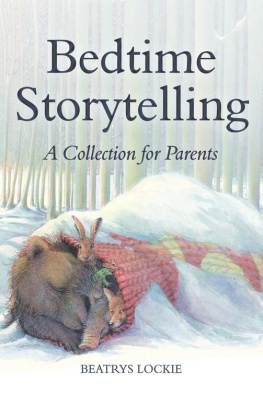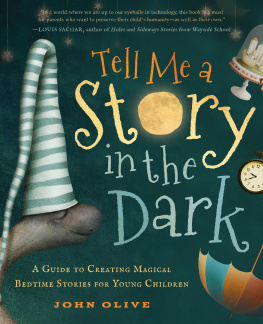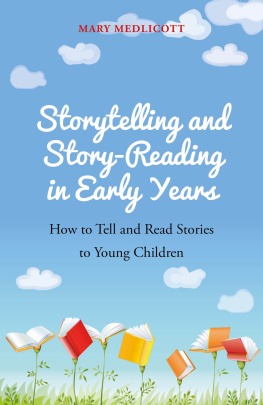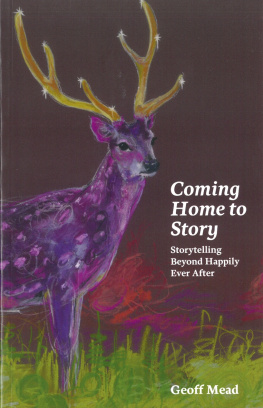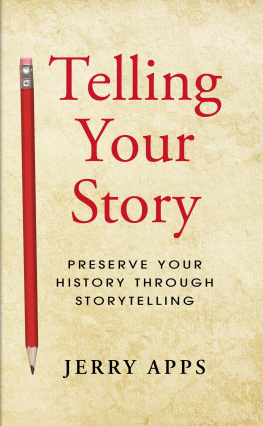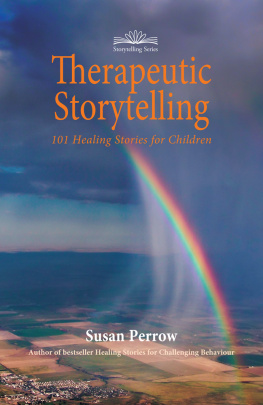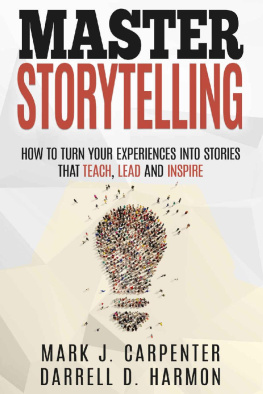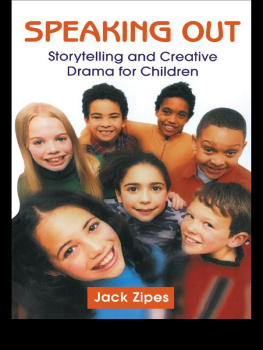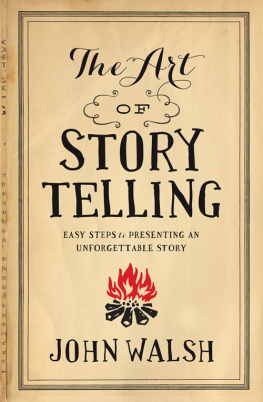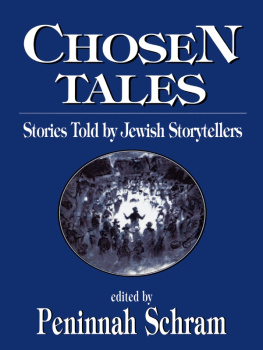Why Tell Stories?
We all love stories. There are so many ways to tell a story: through music, dance, ballet, theatre, with puppets and directly to an audience.
Do you remember being told stories? When did it take place and where? On a parents, grandparents or friends lap? Was it in bed, snugly tucked up before going to sleep: that wonderful space when all is done, before falling into a warm drowse? Or was it only in the holidays when there was time?
Not so many children nowadays have this great experience and yet its an essential tool in their upbringing. For through stories one can create moods and feelings and gently lay down moral views without ramming them down childrens throats. Stories are like food to them. If they dont get them at an early age, its a great loss, never to be regained, which can even affect the childs subsequent emotional life.
Why do children not have stories told to them these days? The honest answer is that it takes time and trouble. What are we grown-ups doing with our time? Mostly working, as we must earn money. But here we should strike a balance between what is good and necessary for our children and what our materialistic society demands of us.
What is so special about telling stories? Well, you have two arms free to gesture as you tell the story you can wipe a nose. But, above all, you have eye contact, which means you can observe and react to how the child feels. If necessary you can stop the story to solve the childs problem and then carry on again.
By contrast, when reading a book (a very good second best), your eyes are on the page and you cannot have such a close relationship with your listener. Nor can you easily hold a child or make gestures. But reading aloud is still better than leaving the child alone to listen to a tape while Mum or Dad gets on with things. First of all, the child is alone so there is no physical contact. Furthermore, who is this person telling the story? Its a disembodied voice. The child cant interrupt to ask a question. Without the human contact the childs mind easily wanders. Perhaps the only justification for using a tape is when travelling in a car; but is it really necessary to entertain children all the time? If one must, then what about guessing games involving the countryside through which you are travelling?
And then there is the television. Again the child is watching alone with no physical contact. The programme, however good, is presented by strangers and often accompanied by short fragmented pictures. The characters very often have limited, stereotyped and jerky gestures, which I have often observed in children who watch a lot of television. Above all, the child is passive an unnatural state for a child to be in and stunting to the imagination.
Its rather like this: have you ever seen a film, say, Rebecca by Daphne du Maurier, and later read the book? As you read the book you simply cannot put the film-star characters out of your mind. Your imagination has been blunted. The reverse is true when you read the book first: your imagination has created all the characters and situations, and if you now see the film you may well be a little disappointed. The images from your imagination are extremely powerful. This shows in a small way what happens when a child watches television. All the images are there, already created for the child, and nothing is left to the imagination. If you must watch television, it would be better to watch together with Mum or Dad, so that you can talk about the programme later.
Getting started
Many people say that they cannot tell stories. Not so. Everyone can! It just takes a little practice. This book is here to help you. There are stories for children aged from three to seven years, grouped according to approximate age range. Of course there will be some variation as not all children develop at the same speed, so its up to the teller to make the final choice.
No one will be bored and they will go to sleep satisfied and comforted. They will look forward to this bedtime special. If you have children of mixed ages, start with a story suitable for the youngest and add another (or two!) for the older ones.
First, start with a short story and commit it to memory. Keep repeating it while you are doing those mindless tasks like washing-up and hoovering. Remember, the younger your audience, the more often they will want to hear that same story again and again. This will give you confidence.
The majority of the stories in this book have repetitive and recurring themes and phrases, especially those in the first section. For example The Little Jug (see page 21) goes to the village to find something for his friend the little girl to eat. He hops down the mountain HOP, HOP, HOP, HOP and goes to the baker, he hops home, he hops back to the village HOP, HOP, HOP, HOP then goes to the butcher etc. Once you have learned the basics of these simple stories, the repetition makes them easy to remember for you and your children. They will keep you right if you dont stay with exactly the same scenario or even the same words as before: You didnt say that last time! Then you can go on to more complicated stories. You can also tell the story in instalments, so they go to sleep wondering whats going to happen next. But you must be firm. No giving way to Please, Mum, just a bit more.
I often introduce a story by speaking directly to the children, and perhaps asking them some questions, to engage and involve them from the very start. For example, in The Harp with Five Strings (see page 129) I start by talking about musical instruments. After naming some instruments, I ask, Can you tell me any others? In Giant Grummers Christmas, I ask the children to name types of cheese (see page 52). This is all part of making the experience active for young listeners and getting their imaginations working. You can interrupt the story at any point to involve children, by asking their opinions, asking them to guess what happens next or to explain ideas that they might not understand. You can use actions to emphasise parts of the story and add an extra dimension (see Giant Grummers Christmas, page 52; Ameliaranne and the Green Umbrella, page 5657; How the Elephant Got its Trunk, page 89). And as you become more experienced, you can get more creative there are endless possibilities.
Creating a Mood
I started telling stories when I was very young to children who were still younger than I. As far as I can recall, they were not read from books but were told and they were entirely made up; they usually concerned flowers, fairies, gnomes and angels. This storytelling was not done regularly but sprang out of circumstances.
Later, when I had my own children, storytelling became more regular, especially at bedtime. In fact, bedtime was never a time of stress; it was always a time to be looked forward to. We established a ritual: bath, pyjamas on, meal, teeth brushed, curtains closed, candle lit and then a story or stories.
Children are fascinated by stories from When I was a little girl (boy) so that can be a good way to start. With older children one could first talk about what happened during the day, possibly sorting out some difficulty and looking forward to whats coming the next day. A night prayer is best said as the very last thing, before the tucking in and a good-night kiss.
After the experience of our own children, when I became a class teacher I simply could not imagine a lesson without a story. Of course, in the Steiner curriculum, all the stories are related to the subject being taught and are suited to the age group. After fifteen years as a class teacher in a Steiner-Waldorf school, I retired and started three kindergartens in succession in different parts of the country. In kindergarten, the story is the most important part of the day. The same story may easily be told for three weeks, so that it becomes fully integrated into the childs soul. I have never had a child complain about the repetition. During the three weeks we would also teach the parents puppetry and have them present a puppet show of (yes, again!) the same story, presented by the parents and told by the teacher. The children would go home fully satisfied and fulfilled, and were always given the opportunity to play peacefully and quietly so that the effect of the story was fully achieved.

